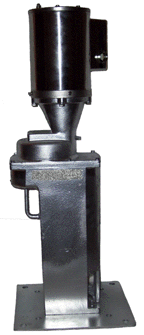 Thinks
to Know:
Thinks
to Know:
Anoxic
Denitrification Mixing is an ecologically important bacterial process that converts reactive nitrogen
compounds to inert nitrogen gas. The discharge of excessive amounts of the
nutrient nitrogen can result in the growth of large amounts of algae
and a zone of low dissolved oxygen (hypoxia), which can stress aquatic life in
receiving waters such as streams, lakes, bays, estuaries, etc. The
primary method of Denitrification is to introduce nitrogen-eating bacteria into
the wastewater. Another method is to
introduce a neutrally buoyant media to which the bacteria anchors itself while
consuming the nitrogen so the effluent can be safely released back into the
water shed or on to further processing.
Generically, bacteria
uses the organic carbon found in waste water as its energy source. Through
bacterial action, faculative bacteria reduce nitrates into nitrites which then
evolves into nitrogen gas which can be properly evolved into to the environment as an
inert (non-reactive) gas (79% found in the environment -air). The process is generally a closed system in that
the mixing system is designed to minimize oxygen absorption from the atmosphere.
Top entering mixers are used to maintain the activated sludge, which encourages
the right biological communities to form resulting in an anoxic condition
suitable for denitrification.
Rugged Specialty Mixer designs are generally used
for this application which includes weed-less impeller designs. Anoxic Mix
tanks generally contain a great deal of fibrous material that would tend to
hang-up upon common propeller & hydrofoil impellers. As rotating
equipment, it is impossible for example to prevent a diaper from wrapping around
a top entering mixer shaft however there is a great deal that can be used to
counteract the effects of this unscheduled debris. The first is to
consider a design that will indicate, from a considerable distance, when the
rotating shaft needs to be cleared of this excessive debris that could weigh in
excess of 100 pounds. The next is to implement an impeller technology that
incorporates features that are not influenced by typical accumulation around the
impeller hub, which is expected. Also, to consider a polished swept back
impeller leading edge which allows debris & fibers to pass through the flow
zone without hanging-up on the impeller. Each of these features have been
incorporated into our design.
As an abusive mixing application, it is important
to incorporate efficient "one-man" servicing in mind. There is
nothing more disheartening to an plant operator than to have to schedule &
wait for a work crew to service the equipment. Keep in mind that all
rotating equipment incorporate wearing elements such as bearings, seals &
gears. A plant technician or operator will needs to efficiently be able to
remove the motor, disassemble the agitator shaft & then impeller suspending
the shaft & impeller from the base plate. Without having to deal with
the mixers support base in any way, the operator can then remove the gearbox for
servicing.
Believe me when I tell you there is nothing more
gratifying to see a 135 pound (female) operator being able to lift this
lightweight gearbox over her head knowing that prior designs required either
work crews or heavy lifting equipment just to get started.
Many facilities incorporate multiple Anoxic
Mixing zones that duplicate several mixing stations where it is not uncommon to
have a back-up spare gearbox assembly. The operator drops in the spare
gearbox, as the design is common to every mixer in the plant, reassembles it,
getting the process back at 100% in no time. The gearbox requiring service
can then be shipped back to our facilities for a factory
rebuild.
Features include an all corrosion resistant
design where the entire mixer is constructed of corrosion resistant
material. Many specifications call out wash down duty motors which today
are very cost efficient all stainless steel designs. The gearbox is
constructed of corrosion resistant "High Strength) corrosion resistant
light weight aluminum which is suitable for 95% plus of every mixing
application. Every other mixer component is 316L {low carbon} stainless
steel using 316SS hardware. As any chemical engineer worth his salt can
tell you the number 1 driver of the world economy is corrosion ... meaning that
you have a wining combination. Isn't it time we all veer ourselves
away from the concepts of planned obsolescence.
06.22.20